by Mary L. Peachin with photography by Bill Kimball and Mary Peachin
Vol. 9 No. 9
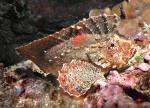 For two decades, I dived the oceans of the world in search of whale sharks. My goal was the thrill of a close-up encounter in underwater silence with these polka-dotted plankton eaters. An aircraft-spotted shark followed by a snorkeling experience was not my preference. My obsession racked up hours of jet lag crossing the international dateline.
For two decades, I dived the oceans of the world in search of whale sharks. My goal was the thrill of a close-up encounter in underwater silence with these polka-dotted plankton eaters. An aircraft-spotted shark followed by a snorkeling experience was not my preference. My obsession racked up hours of jet lag crossing the international dateline.
Several years ago, during the winter whale shark migration in the Andaman Sea, I boarded the Pelagian liveaboard out of Phuket. Local Thai dive boats used to guarantee whale shark sightings or refund your money. By the late 90’s, those guarantees disappeared as fewer whale sharks were sighted. The day I circled one of their favorite seamounts, Richelieu Rock, they were nowhere to be found. A few years later, my search was rewarded by two whale sharks off Darwin Island in the Galapagos. Sadly, they were brief sightings in the worst of diving conditions. Hanging onto a seamount in rushing current, barnacles nipped holes in my gloves. Yet, even a quick glimpse was, for me, one of life’s thrilling moments.
Last spring I decided to give the Andaman one more try. The conditions seemed perfect. Warm 83-degree aqua blue water combined with the greenish bloom of plankton in the usual whale shark seamount hangouts. How could those behemoths deny me?
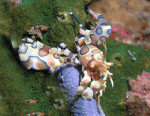 Bang! The religious tradition of lighting firecrackers launched the M/V Aqua One from Thaisarco jetty near Phuket’s deep-sea port, Ao Makham. Our itinerary would take us north to Richilieu Rock then south twelve hours to 5 Islands—Phi Phi being the best known. While we hoped to see whale sharks, those lovable creatures hadn’t made any regular appearances during the season. It is thought that they have joined the list of other sharks that are being killed for their fins for shark fin soup.
Bang! The religious tradition of lighting firecrackers launched the M/V Aqua One from Thaisarco jetty near Phuket’s deep-sea port, Ao Makham. Our itinerary would take us north to Richilieu Rock then south twelve hours to 5 Islands—Phi Phi being the best known. While we hoped to see whale sharks, those lovable creatures hadn’t made any regular appearances during the season. It is thought that they have joined the list of other sharks that are being killed for their fins for shark fin soup.
The “Chicken Divers”, as they called themselves, brought their mascot, a rubber chicken—on this trip he was wearing a SARS protection mask. Chicken was everywhere: prominently displayed on the dining buffet, diving stuffed inside a diver’s shark fin cap, then rigged to the masthead flying in the wind with Buddhist prayer flags and yellow floral necklaces, the traditional blessing of Thai ships. Chicken’s predecessor was eaten after being stuffed with feathers in a bait ball during a shark feed in Papua New Guinea.
Aqua One cruise director Johnny Gallick, an ex-pat from Connecticut, welcomed us aboard then gave the standard boat briefing. We were introduced to our two divemasters, Ali, a “ghost pipe fish expert” and Nusa or Nus for short, a “frog fish specialist”, Tia, who seemed to do everything on the deck and in the salon, and two women servers.
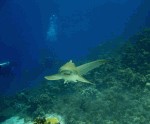 Both divemasters were from Sulawesi, Indonesia. Pointing with a chopstick, Nus Lobbu showed us several ghost pipefish camouflaged in soft coral. While making our safety stop, Ali Unajangabji pointed to two mating octopus, or as they would say in Thailand, they were making “boom-boom.” The two divemasters made every single dive searching for critters to show us. All of us thought they were two of the best divemasters we had dived with anywhere. A grunt reverberating through the water from Ali was the signal that he had spotted an interesting critter
Both divemasters were from Sulawesi, Indonesia. Pointing with a chopstick, Nus Lobbu showed us several ghost pipefish camouflaged in soft coral. While making our safety stop, Ali Unajangabji pointed to two mating octopus, or as they would say in Thailand, they were making “boom-boom.” The two divemasters made every single dive searching for critters to show us. All of us thought they were two of the best divemasters we had dived with anywhere. A grunt reverberating through the water from Ali was the signal that he had spotted an interesting critter
Each diver was assigned a tank and basket for gear. The tanks had pull away holders that allowed the diver to easily stand after gearing up. With only ten or us both the dive deck (and salon) had plenty of room. Tia, always beaming a smile, was there to help if you were struggling with a BC strap or just pulling off your wetsuit. One rainy afternoon, he moved everyone’s drying bathing suit away from the rail. The dozen crew were all gracious and accommodating, almost anticipating every need without a request. They spoke very little English, but all excelled at their jobs.
Snake, snake! My buddy’s voice was loud and clear as he warned of a deadly black banded sea krait slithering over a crevice at a depth of 50 feet at a nameless site in the 5 Islands. Moving quickly, the snake was gone with a quick snap of the camera shutter. The krait was one of three—the other two observed at Richilieu Rock—seen on the trip. But I hadn’t come all the way to the Andaman Sea to dive with sea snakes.
The first day of our 10-day dive trip began in the Similan Marine Park near Island 4, a five-hour boat ride or about 60 miles from Phuket. The nine granite islands are lush with tropical jungle, and offer the non-diver white sandy beaches. Similan, which means “nine” in Malay are identified by a name-in Thai-and as a number for the rest of us.
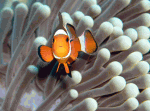 The routine check out dive at Moonlight Bay was simply to see if we were properly weighted. Descending a mere 20 feet, we observed a damsel fish harassing a common octopus seeking refuge in a small coral bommie. In the distance a rare golden color whiptail ray caught my eye. I followed him on the shelf-like bottom to a depth greater than 90 feet. There were cowries, different species of nudibranch, scorpion and lionfish.
The routine check out dive at Moonlight Bay was simply to see if we were properly weighted. Descending a mere 20 feet, we observed a damsel fish harassing a common octopus seeking refuge in a small coral bommie. In the distance a rare golden color whiptail ray caught my eye. I followed him on the shelf-like bottom to a depth greater than 90 feet. There were cowries, different species of nudibranch, scorpion and lionfish.
Boulders, a site with rocks the size of an apartment building, dominated the underwater landscape at Similan Island #2. Two six-foot leopard sharks lazed in the sand at 85 feet. Several blue crown of thorn, spines similar to sea urchins, were inflated like basket stars. Pairs of longfin and phantom bannerfish darted around the rocks. As the current picked up viz drop from 100-foot plus to about 75 feet. Finning behind the huge rocks, we avoided the current. But it didn’t matter where the current carried us, one of Aqua One’s two zodiacs would pick us up. Johnny only asked that we carry safety sausages to protect us from being run over by other boats.
Hin Meon Deeow, located on #5 island, translates in English to “end of the roll.” What an understatement for a photographer’s heaven! The contents of a Thai diving reference book were displayed in a rainbow of hard and soft corals: bubble, red pencil anemones, blue and purple gorgonians overwhelmed by massive staghorn and lettuce coral. Multiple colors of lionfish hung under ledges. Triggerfish dug nests in the sand as a small pipefish drifted in the current. A pair of Oriental sweetlips disappeared into a school of silversides. The anticipated strong current of the drift dive didn’t materialize. When the visibility diminished, we did a 180, swimming back to the boat in the gentlest of current.
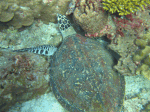 The water was a consistent warm 82 degrees, nothing more than a lycra was necessary, and that was to protect against hydra and the occasional jelly. The air might have been a warm 90-degrees, but we were always in the water. On this trip, by the time the photographers had downloaded photos or eaten a meal, it was diving time. I never lied down for a nap and during the 10-days only two of the divers had time for a brief kayak outing. After the night dive, everyone headed for the sack.
The water was a consistent warm 82 degrees, nothing more than a lycra was necessary, and that was to protect against hydra and the occasional jelly. The air might have been a warm 90-degrees, but we were always in the water. On this trip, by the time the photographers had downloaded photos or eaten a meal, it was diving time. I never lied down for a nap and during the 10-days only two of the divers had time for a brief kayak outing. After the night dive, everyone headed for the sack.
East of Eden is considered one of the more colorful sites in the Andaman, or as the Thai would say “same-same but different.” Its mushroom shaped soft coral head is referred to as a “condo.” Boulders are covered with gorgonian and large sea fans and anemones.
At Snapper Alley we saw a variety of interesting stuff: tiger cowry and spider conch, two ghost pipe fish camouflaged in soft coral, a red long-snout pipe fish hiding among red rods. Blended into the reef was a motionless stonefish. Hanging under ledges were more common, spotfin and black white-lined lionfish. A frenzied oriental juvenile sweetlips thrashed wildly while a Harlequin juvenile sweetlips drifted in the current. We hadn’t anticipated that almost every site would be equally as interesting.
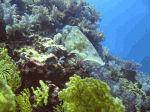 Ko Bon, outside of the Similian Islands, has only been designated a marine park for several years. Damage from dynamite fishing is evident between patches of healthy coral. Mantas circled us curiously, a thrilling experience. The long white antenna of blue-colored spiny lobster, the size of prawns, gave away their location. Clownfish darted from dozens of anemones. We saw black common octopus, moray and sharp-nosed eels, numerous species of nudibranch and a lone reef shark. But in the limited viz created by the plankton, our gaze was continually in the blue searching for the white underbellies (the first identifiable marking) of the manta.
Ko Bon, outside of the Similian Islands, has only been designated a marine park for several years. Damage from dynamite fishing is evident between patches of healthy coral. Mantas circled us curiously, a thrilling experience. The long white antenna of blue-colored spiny lobster, the size of prawns, gave away their location. Clownfish darted from dozens of anemones. We saw black common octopus, moray and sharp-nosed eels, numerous species of nudibranch and a lone reef shark. But in the limited viz created by the plankton, our gaze was continually in the blue searching for the white underbellies (the first identifiable marking) of the manta.
Continuing north, we dived Koh Bon and Koh Tachi, a seamount where we were once again greeted by a manta. The seamount offered an incredible amount of variety. There was a plateau with a batfish cleaning station, white-segmented worms nibbled on barrel sponges, and nudibranchs crawled along the reef. Chevron barracuda, jack, and trevally swam in the swirling currents. A bright yellow day boat, the Klas Lak, dropped a couple dozen divers on the mount roaring its engine above us. How painful to share this great site with day-trippers.
Little did the French explorer Richilieu know that a location he named for himself would become a world famous dive site. The tip of the oval-shaped seamount peeks over the water surface at low tide. Covered with soft coral and sea urchins, whale shark sightings used to be common here –hence its popularity. Unfortunately Richilieu is not part of the Andaman marine park, and when as many as a dozen dive boats leave the site each day, fisherman lower their nets. On our first dive we saw schools of small jack and a hawksbill turtle. The mooring line broke as we hung on it during a safety stop. The Andaman is one destination where you need good buoyancy control and the ability to do a 15-foot safety stop in any location, day or night.
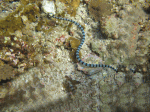 The diving at Richelieu only got better. Our group of gung ho macro shooting photographers couldn’t get enough of the place. We stayed at Richelieu for two and a half days of day and night diving. The “chickens” were thrilled with the rock’s critters. Shrimp were everywhere: red and white Christmasy cleaners and banded coral, cricket-like ridged-back and more Harleguin shrimp. There were ghost pipe fish and a lone cuttlefish hovering over a nest of eggs. Schools of Chevron barracuda circled in the current. A stunning rare red pencil anemone appearing like a stain on the ocean floor, one of those special sitings bypassed by many groups of divers. There were numerous red saddleback tomato anemones. A school of squid pulsated through the current. A hawksbill turtle seemed unruffled by photographers. In one area, clams spawned, shooting sperm like mini-geysers into the water. Large spotted potato cod, being cleaned by wrasse, lazed on rocks. As familiar as we became with the seamont, there was always something new to see; as special as a pair of yellow sea horses.
The diving at Richelieu only got better. Our group of gung ho macro shooting photographers couldn’t get enough of the place. We stayed at Richelieu for two and a half days of day and night diving. The “chickens” were thrilled with the rock’s critters. Shrimp were everywhere: red and white Christmasy cleaners and banded coral, cricket-like ridged-back and more Harleguin shrimp. There were ghost pipe fish and a lone cuttlefish hovering over a nest of eggs. Schools of Chevron barracuda circled in the current. A stunning rare red pencil anemone appearing like a stain on the ocean floor, one of those special sitings bypassed by many groups of divers. There were numerous red saddleback tomato anemones. A school of squid pulsated through the current. A hawksbill turtle seemed unruffled by photographers. In one area, clams spawned, shooting sperm like mini-geysers into the water. Large spotted potato cod, being cleaned by wrasse, lazed on rocks. As familiar as we became with the seamont, there was always something new to see; as special as a pair of yellow sea horses.
Early the next morning, we stopped at a wall along Koh Bida Nok near Phi Phi. The red limestone islands have been the backdrop for many films including those of James Bond. Critters sought refuge along this wall; nudibranch of many species and a pink Devil scorpionfish. A 2-foot octopus clambered over the rocks as a leopard shark basking on the sand swam off as we approached. A cuttlefish swam quickly through the water as though he was headed for a “boom-boom” sex rendezvous. The island had several swim throughs including one filled with glassy sweepers. It was amazing to count 13 other dive boats on our ascent– the Andaman has certainly been discovered! In one swim through, a beginning diver fighting the surge finned me.
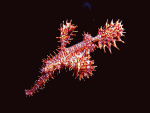 Surely Johnny was kidding. We were changing our itinerary. The previous day a whale shark has been seen at Min Haung-less than two hours southeast of 5 Islands. Before daybreak we arrived at Red and Purple Rock. Red has three small pinnacles jutting out of the watch, while Purple is submerged. Jumping off the dive platform we were descended into the plankton rich water of Purple Rock. Schools of spadefish and barracuda hovered. The anemone covered seamount had lots of critters including a green mantis shrimp and one gorgeous concentric green and blue juvenile emperor angelfish. Once again the whale shark eluded us.
Surely Johnny was kidding. We were changing our itinerary. The previous day a whale shark has been seen at Min Haung-less than two hours southeast of 5 Islands. Before daybreak we arrived at Red and Purple Rock. Red has three small pinnacles jutting out of the watch, while Purple is submerged. Jumping off the dive platform we were descended into the plankton rich water of Purple Rock. Schools of spadefish and barracuda hovered. The anemone covered seamount had lots of critters including a green mantis shrimp and one gorgeous concentric green and blue juvenile emperor angelfish. Once again the whale shark eluded us.
The next dive we searched at Purple rock. Back at the boat, we heard that the whale shark had been sighted at Red rock. We were so close, but the green of the plankton-rich water diminished visibility to about 25-feet. Hearing about the whale shark siting, we jumped in the zodiac heading back to Purple rock. Some of us jumped in the water with snorkels, others wearing scuba gear. We searched to no avail. Returning to Purple rock, the plankton was soupy, but we were fortunate to have 12-foot majestic black mantas circling in view. The conditions were perfect for a whale shark, but even though we hung out for more than an hour, none appeared.
The visibility decreased and the current picked up, it was like instrument flying through the clouds. Almost everyone had to be picked up a long distance from the boat including one diver who chased a manta and was found moments after the sun set. When he flashed his camera strobe to note his location, he was a good half-mile from the boat. On this trip, seeing a whale shark wasn’t meant to be, but the mantas were a fabulous consolation.
 There was no authoritative 24-hour “no-fly” rule. We each made our own determination based on our individual computer readings. On our final day, some of us were able to make two dives, some three. At Koh Yuhn, two hours south of Phuket, we stayed shallow, about 50-feet, doing muck dives. In the sandy 25-foot viz, we found unbelievable critters like small speckled frogfish, velvetfish, red seahorses, sea moths, leather jackets, column anemones with transparent shrimp, sea pen, and small flounder and octopus. The dives, once again were “as advertised” in Johnny’s briefing. Even the Thai fish guide nudibranch “cover girl”, Thecacera–the spotted tiger-stripped two appendage (a pair on both its rhinophores and gills) posed for us.
There was no authoritative 24-hour “no-fly” rule. We each made our own determination based on our individual computer readings. On our final day, some of us were able to make two dives, some three. At Koh Yuhn, two hours south of Phuket, we stayed shallow, about 50-feet, doing muck dives. In the sandy 25-foot viz, we found unbelievable critters like small speckled frogfish, velvetfish, red seahorses, sea moths, leather jackets, column anemones with transparent shrimp, sea pen, and small flounder and octopus. The dives, once again were “as advertised” in Johnny’s briefing. Even the Thai fish guide nudibranch “cover girl”, Thecacera–the spotted tiger-stripped two appendage (a pair on both its rhinophores and gills) posed for us.
There was no drudgery at the end of this 10-day dive trip. Before I had peeled off my skin, Tia, who served us ice water before the dive and a hot towel afterwards, had my gear rinsed in clean water and drying on the comfy lounge cushions on the bow of the boat. The variety of diving and camaraderie and fun loving attitude of the group, a superb and eager staff made this trip extra special. There were large mantas and a few leopard sharks, and sadly for me, no whale sharks. There were corals and critters I have never seen in 25-years of diving: all making this a remarkable trip.
If you go:
Thailand is about 14 degrees north of the equator with hundreds of small islands than dotting more than 1200 miles of coastline. The popular destination of Mu Ko Similan in Phang-Nga province was designated a marine park in 1982. The 10-day trip costs $3075.00. Economy class on Singapore Airlines is USD 1,214.50. A new nonstop flight has been added which costs about $300.00 more. Nitrox was $10 a tank or $160 for the trip. www.dive-aquasports.com or aquaone@dive-aquasports.com
